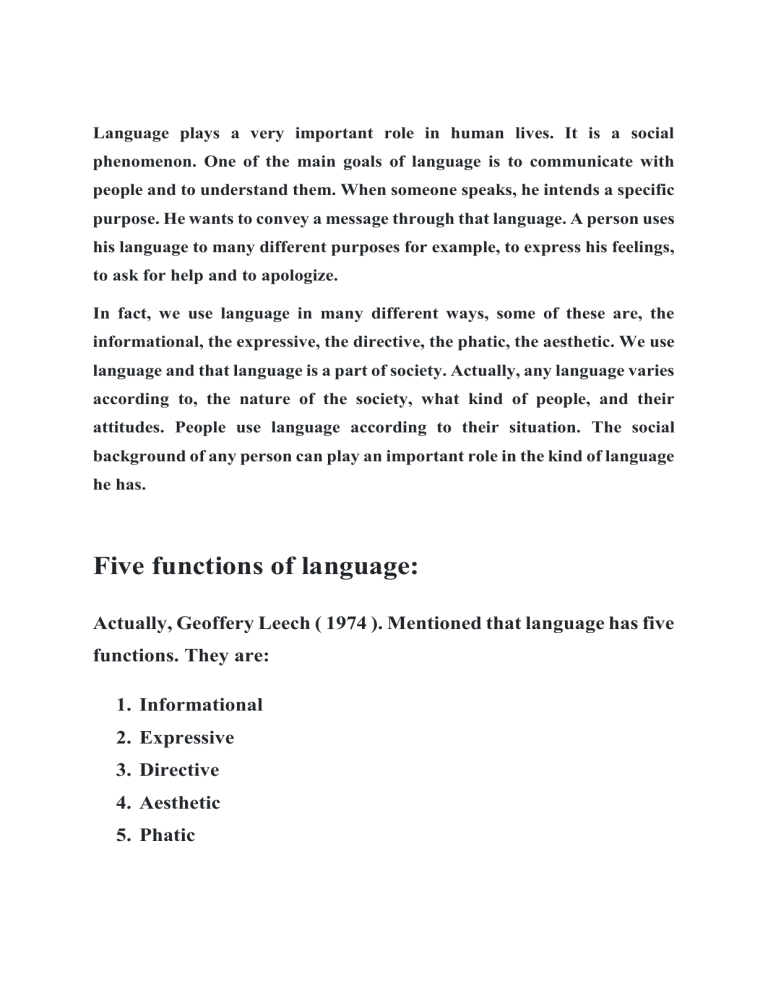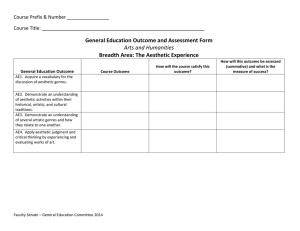
Language plays a very important role in human lives. It is a social phenomenon. One of the main goals of language is to communicate with people and to understand them. When someone speaks, he intends a specific purpose. He wants to convey a message through that language. A person uses his language to many different purposes for example, to express his feelings, to ask for help and to apologize. In fact, we use language in many different ways, some of these are, the informational, the expressive, the directive, the phatic, the aesthetic. We use language and that language is a part of society. Actually, any language varies according to, the nature of the society, what kind of people, and their attitudes. People use language according to their situation. The social background of any person can play an important role in the kind of language he has. Five functions of language: Actually, Geoffery Leech ( 1974 ). Mentioned that language has five functions. They are: 1. Informational 2. Expressive 3. Directive 4. Aesthetic 5. Phatic “Informational function which everyone tends to assume is most important” Geoffery Leech( 1974 ). In fact, this function concentrates on the message. It is used to give new information. It depends on truth and value. Let us look at this example, the car is big, the bus is crowded. “Language can have an expressive function: that is, it can be used to express its originator’s feelings and attitudes – swear words and exclamations are the most obvious instance of this”. Geoffery Leech( 1974 ). The speaker or writer of this function tries to express his feelings. He or she reflexes his or her impression. This function could give a clear image for the personality of the speaker or writer. The best example of this kind is Poetry and literature. In fact, this function evoke certain feelings and express feelings. Examples of this kind are, I am very happy or I spent a wonderful vacation. We can see from the previous examples that they reflex the feelings of the speaker or the writer. The third function of language is the directive function whereby we aim to influence the behavior or attitudes of others. The most straightforward instances of the directive function are commands and requests. This function of social control places emphasis on the receiver’s end, rather than the originator’s end of the message: but it resembles the expressive function in giving less importance, on the whole, to conceptual meaning than to other types of meaning, particularly affective and connotative meaning” Geoffery Leech( 1974 ). Examples of this kind are, I want a cup of tea or close the door. It is clear here that, we use the language in a direct way. We ask someone to do something. Sometimes we can use a sentence to express two functions. For example, I am thirsty. The previous example could be used to show the condition of the speaker or writer or to express the feeling. In a way that a person asks someone to give him water. The fourth function is the aesthetic function, which is ‘the use of language for the sake of the linguistic artifact itself, and for no purpose. This aesthetic function can have at least as much to do with conceptual as with affective meaning” Geoffery Leech 1974 ). The function associated with the message-the vehicle-is the poetic or aesthetic function: the sign taken as an end in itself. All art understood as art is taken to embody this function, and any object valued for its beauty rather than for its ideological value or usefulness-whether a gorgeous car, an elegant teapot, or some acreage of untouched real estate-takes on this function. Although Jakobson, perhaps more precisely than anyone who preceded him, showed how the aesthetic function could hinge on structure, he argues that cultural norms ultimately determine the dominance of this function. As a striking demonstration, he notes that the aesthetic status that one generation accorded only to the poems of Karel MÃ, a subsequent generation accords only to his diaries. Jakobson, R. (1933)”. According to Leech, the fifth function is the phatic function. the function of keeping communication lines open, and keeping social relationships in good repair ( in Britain culture, talking about the weather is a well-known example of this)”. Geoffery Leech ( 1974 ). We can say about this function that it is used for normal talks. An example of this, when two people meet each other accidently in a place. They start talking about something unimportant for the sake of communication like, how are you? How is your children? And so on. We can say that it is a kind of daily talking. It is not meaning but is good.



